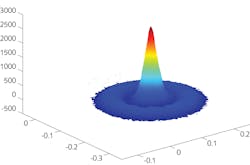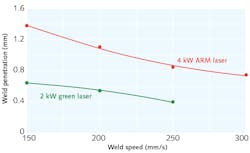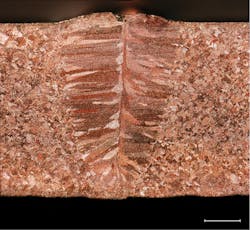The laser powers e-mobility
This article presents the results of successful copper welding tests performed with a new type of Adjustable Ring Mode (ARM) fiber laser having a high-brightness center beam. In this experiment, the high-brightness ARM laser delivered excellent weld quality, and better penetration at various weld speeds, than commercially available kilowatt-class green lasers. These results indicate that this technology could bring all the cost, reliability, and practical advantages of fiber lasers to the demanding task of copper welding.
E-mobility manufacturing
The boom in e-mobility manufacturing is the main factor driving a significant increase in the demand for copper welding solutions. This is because copper possesses a number of desirable electrical, thermal, mechanical, and cost characteristics as compared to other metals.
However, the same high electrical and thermal conductivity characteristics that make copper ideal for e-mobility also make it challenging to weld with traditional fiber lasers. Specifically, its electronic properties make it highly reflective at the near-infrared (near-IR) wavelength of fiber lasers. And, its excellent thermal conductivity necessitates the input of a large amount of laser energy in order to melt the material and initiate the welding process.
As a result, copper laser welding with traditional fiber lasers usually needs a very-high power density to initially melt the material. But, this “brute force” approach makes the welding process unstable and extremely sensitive to minor variations in the work surface. In particular, the presence of localized surface oxidation or small-scale surface structure inhomogeneities can result in process instabilities. The final result may be inconsistent welds, poor surface quality, and porosity.
Solid-state green lasers
Copper is nearly an order-of-magnitude more absorptive in the green than the near-IR. This makes it easier to initiate the welding process at this wavelength, and it has been thought that this delivers a more-stable and less-sensitive process than possible with fiber lasers. As a result, high-power, solid-state green lasers are being utilized by a few manufacturers, and evaluated by many more.
However, there are some significant practical issues with deploying high-power green lasers in e-mobility manufacturing. First, the inefficiency of the frequency doubling process used to convert the infrared (IR) solid-state laser output to green produces a substantial amount of waste heat at the multikilowatt power level. This necessitates a water-cooled heatsink and a high volume of cooling water. It also results in a relatively high cost of operation due to electrical power consumption.
There are also some difficulties with beam delivery of green light. In particular, the standard optical fibers used for beam delivery are more readily darkened by green light than IR, thus reducing their useful lifetime. Specialized fibers for green light can overcome this problem, but are more expensive and less readily available. The darkening effect also increases with the length of the fiber. This currently limits fiber length to 10 m, which reduces the flexibility in laser placement in the production environment.
The HighLight ARM fiber laser
Fiber lasers are much more electrically efficient than solid-state green lasers, meaning that they require less electricity and produce less waste heat. This reduces cost of ownership and simplifies cooling. Plus, fiber lasers are very reliable, and their IR output is readily fiber-delivered. This unique combination of cost, reliability, and practical advantages makes fiber lasers the choice for many industrial applications. But, despite these desirable features, they haven’t been widely used for welding copper in particular because of the issues previously identified.
Coherent (Santa Clara, CA) introduced its HighLight Series Adjustable Ring Mode (ARM) fiber lasers several years ago for applications that were not being adequately addressed by traditional technology. Typically, these are tasks in which the spatial distribution of power and power density at the work surface must be carefully controlled in order to yield good weld quality (low spatter, minimal cracking, and reduced porosity). Typical examples are zero-gap welding of galvanized steel, spatter-free welding of powertrain components, and welding of aluminum hang-on parts with no cracking, without using filler wire.
The technology employed by these lasers has been described in Industrial Laser Solutions in the past (see http://bit.ly/ILS-ARM1 and http://bit.ly/ILS-ARM2). Briefly, they utilize an output beam consisting of a central spot, surrounded by another concentric ring of laser light. The power in the center and the ring can be independently adjusted and modulated on demand, and this enables very careful control over the melt pool dynamics.
The latest innovation in this technology is an ARM laser that produces a high-intensity, high-brightness, low M2 center beam. This is particularly advantageous for copper welding because the high-brightness center beam provides the energy required to readily melt the material, despite its relatively low absorption coefficient, while the ring beam helps stabilize the keyhole. The result is that the welding process is initiated and maintained consistently, regardless of surface variations in the workpiece, thus overcoming the limitations experienced with traditional fiber lasers.
Copper welding results
Copper welding was assessed in a series of tests at Coherent using an ARM laser having a high-brightness center beam (22 µm diameter), and a ring beam having an inner/outer diameter of 100 µm/170 µm. The laser was focused using a remote processing head with a magnification of 1.4, with nitrogen as shielding gas and cross jet. The material welded was pure copper. The laser power was 4 kW, with 1.5 kW in the center and 2.5 kW in the ring for all tests. Initial testing showed that optimum results (best compromise between weld penetration, spatter, and surface quality) were achieved with the beam focused 1.5 mm above the work surface. The beam profile for these conditions is shown in Figure 1.
Figure 2 plots weld penetration on 2-mm-thick copper as a function of speed under the conditions just described. A 2 kW green laser was also tested under the same conditions for comparison (this is the highest-power green laser currently available). The IR ARM laser delivered twice the weld penetration over a wide range of weld speeds.Conclusion
These tests demonstrate that the Coherent high-brightness ARM laser is an effective solution for demanding copper welding applications in e-mobility. Weld penetration and process speed match or exceed current production requirements. And, the ARM laser avoids the sensitivity to surface quality and process instability problems that have limited the use of fiber lasers for copper in the past. Fiber lasers, which have been the source of choice for so many industrial applications due to their superior reliability and ease-of-use, together with lower cost-of-ownership, are now ready to tackle copper welding.
About the Author
Klaus Kleine
Director Laser Applications, Coherent
Klaus Kleine is Director Laser Applications at Coherent (Santa Clara, CA).
Falk Nagel
Welding Engineer, Coherent
Falk Nagel is a Welding Engineer at Coherent-Rofin (Hamburg, Germany).



